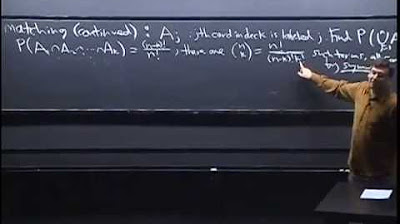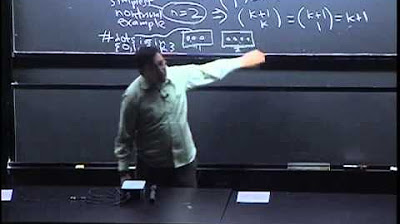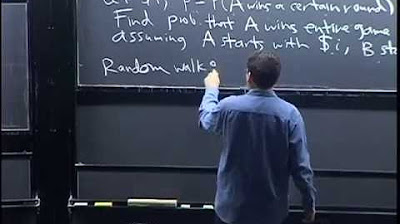Lecture 3: Birthday Problem, Properties of Probability | Statistics 110
TLDRThe video script discusses the famous Birthday Problem in probability theory, which questions the likelihood of at least two people in a group sharing the same birthday. The lecturer explains the problem's relevance to computer science, particularly in data structure collisions. The solution involves making assumptions about the distribution of birthdays and using the Pigeon Hole Principle for cases where the group size exceeds 365. The script also introduces the non-naive definition of probability, relying on two axioms: the probability of the empty set being 0 and the full sample space being 1, along with the principle of disjoint events. The lecture further explores the properties of probability, such as the complement rule and the inclusion-exclusion principle, which are applied to solve more complex probability problems like de Montmort's matching problem. The script concludes with an approximation of the probability involving the mathematical constant e, highlighting the surprising appearance of this constant in seemingly unrelated problems.
Takeaways
- 🎉 The Birthday Problem is a classic probability puzzle that asks how many people are needed in a room to have a 50% chance that two people share the same birthday.
- 🤔 Surprisingly, only 23 people are required to reach a slightly over 50% chance of a shared birthday, which is counterintuitive given there are 365 days in a year.
- 📅 The solution to the Birthday Problem assumes there are 365 days in a year, equally likely for any birthdate, and that each person's birthday is independent of the others.
- 📊 The probability of no matches among K people is calculated by considering each person's birthday to be unique, resulting in a product of 365 minus the person's index plus 1.
- 🛑 The total probability of at least one match is found by subtracting the probability of no matches from 1, using the formula 1 - (365 - K + 1) / 365^K.
- 🧮 For larger groups, the probability of a match increases rapidly; for instance, with 50 people, the chance is about 97%, and with 100 people, it's over 99.999%.
- 📚 The concept of independence is crucial in probability theory, meaning the outcome of one event does not affect the outcome of another.
- 📝 The principle of inclusion-exclusion is introduced as a method for calculating the probability of combined events that are not mutually exclusive.
- 🔢 The general formula for inclusion-exclusion involves summing the probabilities of individual events, subtracting the probabilities of pairs of intersections, adding back triple intersections, and so on.
- 🃏 A historical example problem, de Montmort's matching problem, involves calculating the probability of matching card positions to their values in a deck, which is solved using inclusion-exclusion.
- 🎯 The final solution to de Montmort's problem resembles the Taylor series for e^x, leading to an approximate result of one minus one over E, showcasing the surprising appearance of the mathematical constant e.
Q & A
What is the Birthday Paradox and why is it considered surprising?
-The Birthday Paradox is a probability problem that deals with the likelihood of two or more people sharing the same birthday in a group. It's surprising because the probability of at least two people sharing a birthday in a group of just 23 people is slightly over 50%, which is counterintuitive given there are 365 days in a year.
Why is the Birthday Problem important in computer science?
-The Birthday Problem is important in computer science because it relates to the concept of 'collisions' in data structures. When storing information, it's crucial to understand the probability of two pieces of data being stored in the same way, which can lead to errors or inefficiencies.
What is the Pigeon Hole Principle and how does it apply to the Birthday Problem?
-The Pigeon Hole Principle is a mathematical concept that states if you have more pigeons than pigeon holes, then at least one pigeon hole must contain more than one pigeon. In the context of the Birthday Problem, if there are more people (K) than days in a year (365), then there must be at least one day with more than one person sharing a birthday.
How does the concept of 'independence' apply to the Birthday Problem?
-In the Birthday Problem, 'independence' assumes that one person's birthday does not affect another's. This means the probability of one person having a particular birthday is not influenced by the birthdays of others in the group.
What is the non-naive definition of probability and what are its axioms?
-The non-naive definition of probability involves two axioms. The first axiom states that the probability of the empty set is 0, and the second axiom states that the probability of the full sample space equals 1. These axioms provide a foundational framework for understanding and calculating probabilities in various scenarios.
What is the inclusion-exclusion principle and how is it used in probability?
-The inclusion-exclusion principle is a method used in probability to calculate the probability of the union of multiple events. It involves adding the probabilities of individual events, then subtracting the probabilities of their intersections, and so on, alternating between addition and subtraction to account for overcounting and undercounting.
What is the matching problem in probability theory and how is it related to the Birthday Problem?
-The matching problem, also known as de Montmort's problem, involves a deck of cards labeled 1 through n, where the goal is to find the probability that at least one card matches its position in the deck. It is related to the Birthday Problem in that both involve calculating the probability of at least one match in a set of items, and both can be effectively solved using the inclusion-exclusion principle.
Why is the number e (Euler's number) relevant to the matching problem?
-The number e appears in the solution to the matching problem because the sum of the probabilities, which involves an alternating series of fractions with factorials in the denominator, resembles the Taylor series expansion of e^x. Specifically, the probability of at least one match in the matching problem is approximately 1 - 1/e.
How does the symmetry in the matching problem simplify the application of the inclusion-exclusion principle?
-The symmetry in the matching problem allows us to assume that the probability of any card matching its position is the same, regardless of its label. This means we can use the same probability for each event in the inclusion-exclusion principle, simplifying the calculation and reducing the problem to a series of terms involving factorials and combinations.
What is the significance of the factorial function in calculating probabilities in the matching problem?
-The factorial function is significant in the matching problem because it represents the number of possible permutations of the remaining cards in the deck after fixing the positions of some cards. It is used to calculate the probabilities of intersections of events (e.g., P(A1 intersect A2)) in the inclusion-exclusion principle.
How does the concept of 'disjointification' help in applying the inclusion-exclusion principle?
-Disjointification is a technique used to rewrite the union of two or more events as a union of disjoint events. This is helpful in applying the inclusion-exclusion principle because the principle directly applies to the sum of probabilities of disjoint events. By creating a disjoint representation of the union, we can accurately calculate the probability without double-counting any events.
Outlines
🎉 Introduction to the Birthday Problem
The speaker begins by introducing the Birthday Problem, a classic probability scenario that is often surprising to those unfamiliar with it. They explain that the problem involves determining the likelihood of at least two people in a group sharing the same birthday. The importance of the problem in probability theory is emphasized, and the speaker expresses their intention to delve into how one should think about and approach the problem, rather than just providing an answer.
📚 Assumptions and Initial Analysis
The speaker outlines the assumptions necessary for solving the Birthday Problem, such as excluding February 29th and assuming that each of the 365 days is equally likely for a birthday. They also assume independence, meaning one person's birthday does not affect another's. The speaker then sets up the problem mathematically, considering a group of K people and aiming to find the probability of at least two having the same birthday. They touch upon the similarity of this problem to the robberies problem previously discussed in class.
🧮 Calculating the Probability of No Match
To solve the Birthday Problem, the speaker decides to first calculate the probability of no matches, which is easier to compute. They use the naive definition of probability, given the assumptions of equally likely birthdays. The calculation involves multiplying the number of days available for each subsequent person's birthday, after excluding the birthdays already taken by those before them in the group. The formula for the probability of no match is derived, and the speaker emphasizes the importance of being careful with the number of terms in the product.
🤔 Intuition and Application in Computer Science
The speaker discusses the intuitive understanding of the Birthday Problem when the number of people K exceeds 365, noting that the probability of a match is 100%. They also highlight the relevance of the problem in computer science, particularly in data structures and the occurrence of collisions. The speaker then shares common misconceptions about the number of people needed to reach a 50/50 chance of a birthday match and reveals the surprising answer that only 23 people are needed.
📈 Probability Calculations and Insights
The speaker provides the mathematical computation for the probability of a birthday match as people are added to the group, starting from 23 people and moving up to 50 and then 100. They show that the probability increases significantly as the group size grows. The speaker then offers insight into why the probability is so high with a relatively small number of people, emphasizing the importance of considering the number of pairs rather than just the number of individuals.
🎂 Generalizing the Birthday Problem
The speaker extends the Birthday Problem to consider not just matches but also near-matches, where people have birthdays one day apart. They state that with this new condition, only 14 people are needed to reach a better than 50/50 chance of a coincidence, which is even more surprising. The speaker acknowledges that proving this result is more complex and promises to cover approximation methods for such problems later in the course.
📚 Non-Naive Definition of Probability
The speaker transitions back to the non-naive definition of probability, which involves two axioms. They review the axioms: the probability of the empty set is 0, and the probability of the full sample space is 1. The speaker also discusses the concept of events as sets and the importance of understanding that the probability of a union of events equals the sum of their individual probabilities, provided the events are disjoint.
🔢 Properties of Probability
The speaker outlines several properties of probability that can be derived from the axioms. They start with the fact that the probability of the complement of an event A equals 1 minus the probability of A. They then discuss the property that if an event A is contained within event B, the probability of A is less than or equal to the probability of B. The speaker also introduces a more complex property regarding the probability of the union of two events, which involves adjusting for the overlap between the events.
🤝 Inclusion-Exclusion Principle
The speaker introduces the inclusion-exclusion principle, a method for calculating the probability of the union of more than two events. They explain the principle using the example of three events and then generalize it for n events. The formula involves summing the probabilities of the individual events, subtracting the probabilities of their intersections, and so on, with alternating signs. The speaker emphasizes the utility of this principle in various probability problems.
🃏 de Montmort's Problem and Application of Inclusion-Exclusion
The speaker presents de Montmort's problem, a classic probability puzzle related to a card game. The game involves turning over cards in sequence and matching their position in the deck with their numerical value. The speaker outlines the problem and indicates that inclusion-exclusion is a suitable method for finding the probability of at least one match occurring in the deck. They set up the problem for solution, defining the events and preparing to apply the inclusion-exclusion principle.
🔁 Symmetry and Simplifying Calculations
The speaker simplifies the calculations for de Montmort's problem by taking advantage of the symmetry in the game. They calculate the probability of a single match and then the probability of double matches, using factorials to represent the possible arrangements of the deck. The calculations are shown to simplify significantly due to the symmetry and the structure of the problem, leading to a clear pattern in the results.
🎉 Conclusion and Taylor Series Connection
The speaker concludes the discussion by noting that the exact answer to the probability calculation in de Montmort's problem results in an alternating sum that resembles the Taylor series for e^x. They express surprise at the appearance of the mathematical constant e, highlighting the unexpected connections that can emerge in probability problems. The speaker ends with a reminder of the importance of understanding the underlying concepts and techniques.
Mindmap
Keywords
💡Birthday Problem
💡Probability
💡Complement of an Event
💡Independence
💡Pigeon Hole Principle
💡Leap Year
💡Sample Space
💡Axiomatic System
💡Inclusion-Exclusion Principle
💡de Montmort's Problem
💡Taylor Series
Highlights
Introduction to the Birthday Problem, a classic probability puzzle that explores the likelihood of at least two people sharing the same birthday in a group.
Explanation of the counterintuitive result that only 23 people are needed to have a greater than 50% chance of a birthday match, surprising to most.
Assumption of 365 days in a year for simplicity, excluding February 29th, and the assumption that each day is equally likely for a birthday.
Discussion on the independence of birthdays, meaning one person's birthday does not affect another's, a key assumption in the problem.
The use of the Pigeon Hole Principle to explain why a match is certain with more people than days in a year.
Importance of the Birthday Problem in computer science, particularly in data structures and the occurrence of collisions.
Computational approach to finding the probability of no matches in a group, leading to the calculation of the probability of at least one match.
The probability of a birthday match with different group sizes, such as 50 people (97% chance) and 100 people (99.999% chance).
Intuitive explanation involving the concept of combinations, specifically K choose 2, to understand the increase in possible pairs as the group size grows.
Mention of a related problem where not only the same birthday but also birthdays one day apart are considered a match, which lowers the number to 14 people.
Philosophical and practical implications of coincidences and how the Birthday Problem fits into the broader concept.
Introduction to the non-naive definition of probability, using axioms to formalize the concept.
Explanation of the probability axioms, including the probability of the empty set being 0 and the full sample space being 1.
Derivation of basic properties of probability using the axioms, such as the probability of a complement and the relationship between contained events.
Proof of the general inclusion-exclusion principle, a method for calculating the probability of the union of multiple events.
Application of the inclusion-exclusion principle to de Montmort's matching problem, an old probability problem involving card games.
Solution to de Montmort's problem using inclusion-exclusion, leading to an approximation of the probability involving the mathematical constant e.
Highlight of the surprising appearance of the constant e in a seemingly unrelated problem, demonstrating the ubiquity of mathematical constants in probability.
Transcripts
Browse More Related Video

Lecture 4: Conditional Probability | Statistics 110

Birthday probability problem | Probability and Statistics | Khan Academy

Lecture 2: Interesting problems in probablity

Lecture 2: Story Proofs, Axioms of Probability | Statistics 110

4.2.6 Addition and Multiplication Rules - The Principle of Redundancy and the Multiplication Rule

Lecture 7: Gambler's Ruin and Random Variables | Statistics 110
5.0 / 5 (0 votes)
Thanks for rating: